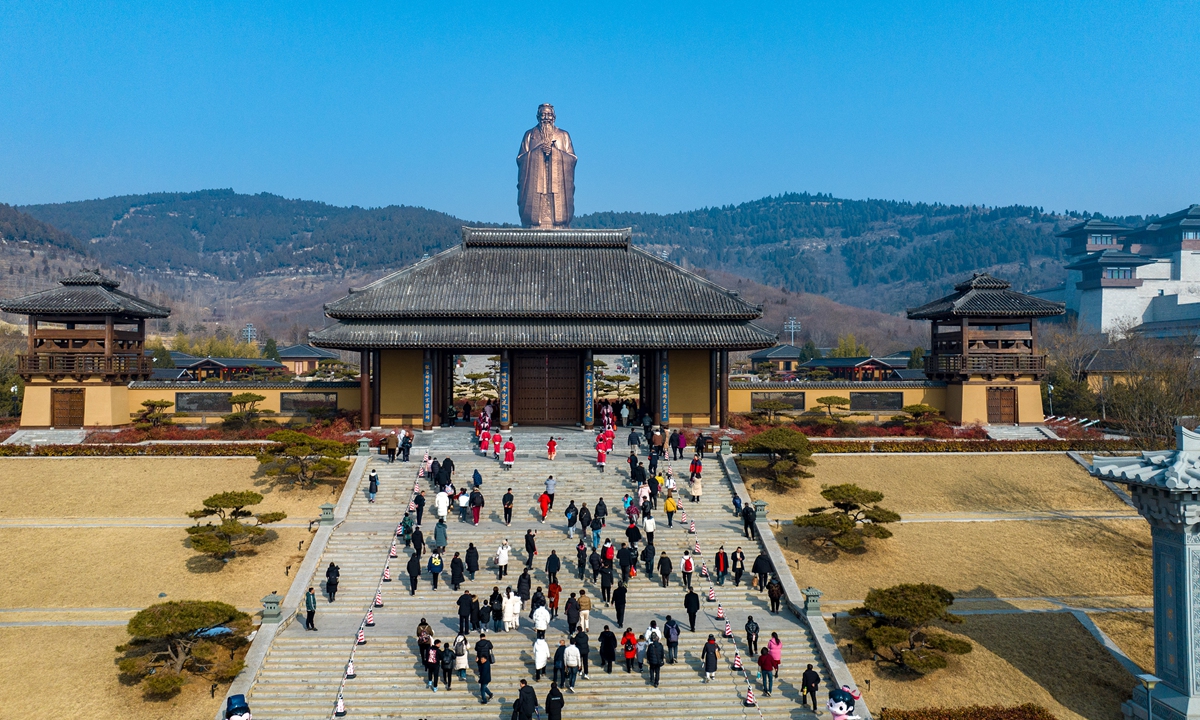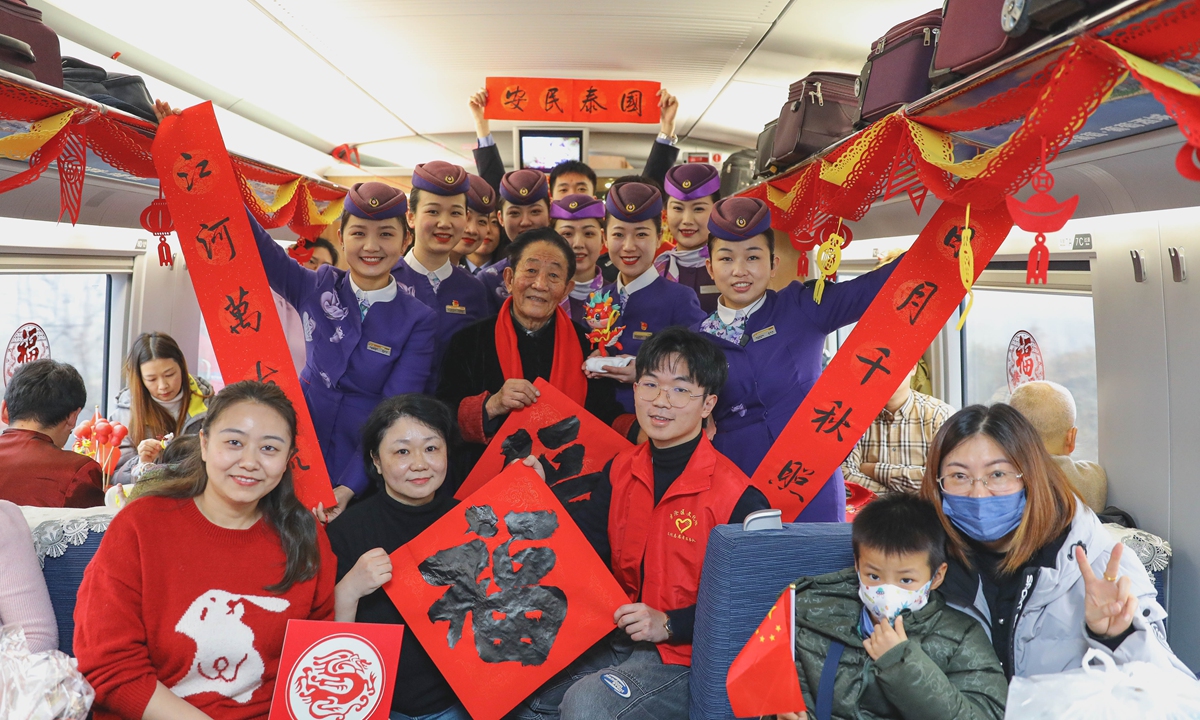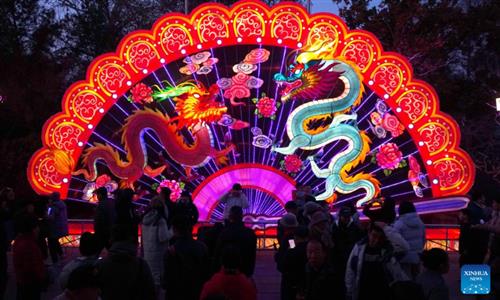IN-DEPTH / IN-DEPTH
Hometown witness: Spring Festive spirit remains unfaded in Shandong, the birthplace of Confucian culture
Cherishing the old, embracing the new
Editor's Note:
The world recently celebrated a splendid Chinese New Year, welcoming the Year of the Dragon.
During the holidays, Global Times reporters returned to their hometowns where they were reacquainted with old traditions and introduced to new post-pandemic experiences. To share their experience, we have launched the "Hometown Diary" series. Spanning from north to south, east to west, six articles will focus on different provinces, exploring the development and evolution from traditional to modern, and from economic to cultural dimensions.
This series is not only a comprehensive review of China's vast territory and diverse regional cultures but also a profound reflection of how different areas across the country maintain their identity and embrace changes.
Through the lens of hometown observations, we hope to touch the hearts of our readers, allowing everyone to find resonance in these stories and feel the warmth and vitality that hometowns provide, regardless of changes brought about by time.
This is the first installment in the series, in which we gain the perspectives of our reporters to understand how North China's Shanxi grabs cultural heritage to attract tourists after its green energy revolution, and how East China's Shandong strikes a balance between tradition and modernity amidst intense population mobility.

Whenever the Spring Festival approaches, people walking on the streets always discuss the "festive vibe."
"The festive feeling is fading," some people would say, especially when one starts a conversation with a distant relative or a taxi driver.
In the context of rapid change, people often lament the dilution of the festive spirit, worrying that the essence of traditional festivals is gradually dissipating amid the flood of modern living.
But this is far from reality. With the convenience of transportation and overall societal progress, I find that the festive spirit is alive and well. These changes have made our Chinese New Year celebration more colorful and diverse.
Although the forms have changed, the longing for a reunion and the core significance of celebrating the Spring Festival remain unchanged: Tradition and modernity can coexist, jointly creating happy and joyful memories.
Reunion is always the theme
My hometown of Shandong in eastern China is known as the land of propriety, where Confucius and Mencius, the most important founders of Confucianism, were born. Their thoughts have shaped the culture and etiquette of China and even permeated through the entire East Asia.
Therefore, Shandong has inherited the most solemn rituals and customs, some of which have even evolved into urban legends that awe people from other regions.
For example, one of the most typical traditions is an obsession with the specific seating arrangement for people of different statuses around a round dining table, to which Shandong people adhere earnestly.
Only second to this adherence is the Shandong people's obsession with returning to their hometown for the New Year. They may work and live in big cities like Beijing, but during the festive season, they return to their small county towns or villages where their parents still reside.
Confucius explained filial piety many times. He said: "While his parents are living, a son should not go far abroad; if he does, he should let them know where he goes."
Since I was one year old, I have traveled back to my "old hometown" in Juye county, Heze, every Spring Festival, where my father is from and his parents were living, from the provincial capital Jinan where I lived.
Juye has almost no claim to fame, though locals claim it to be the birthplace of the Qilin, a legendary creature in Chinese mythology.
When I was young, the biggest form of entertainment in Juye, this small county, was a Xinhua bookstore. So every New Year, when people working outside the city returned and children were on holiday, it became a lively and busy playground. As a child, I looked forward to every aspect of the Spring Festival - posting Spring Festival couplets, buying snacks, playing fireworks, watching the Spring Festival Gala, and, of course, receiving red envelopes, a traditional gift for children or elderly people during Chinese New Year.
I had a great time, but it came at a cost. The only way traveling there from Jinan, the capital city of Shandong, 25 years ago was by the "green trains." They were slow, featuring a five- to six-hour journey spent in crowded conditions, often without seats, and prone to delays.
Such arduous journeys became a source of anxiety in my childhood. Once, because it was too crowded to board the train, my dad tried to pass me through the window, and strangers were willing to catch me. But I refused, I was too scared.
In the year before China downgraded its management of the COVID-19, this unknown county of Juye got its own high-speed railway station. It was a result of Shandong Province's campaign to develop its transportation network.
Now, from one of the high-speed rail stations near my home in Jinan to Juye county is a two-hour journey. And it is on a comfortable 'Harmony' high-speed train, where everyone has a sofa seat.
Today, as of the end of 2023, total operating mileage of high-speed rail in Shandong has surpassed 2,800 kilometers, jumping to first place in the country. Meanwhile, with the commencement of full operation of the Jinan-Zhengzhou high-speed railway route on December 8, 2023, 15 out of 16 cities in Shandong have access to high-speed rail.
The issue of crying children aboard is also a thing of the past. On a recent high-speed rail trip from Beijing to Shanghai, I experienced the quiet carriage. The train attendant was on high alert like a middle school teacher, immediately stopping any attempts to talk or make phone calls. You can sleep or work in peace.So, has the festive spirit faded? Perhaps the children of today do not look forward to returning to their rural hometowns as much as I did in my childhood, because of the ease of reunions that has transformed them almost quotidian-like.

Amid the sound of firecrackers
Since I was eight, the Spring Festival has always held the promise of jubilant fireworks displays and blasts.
Gunpowder is one of the four great inventions of ancient China. Legend has it that the sound of firecrackers scares away the "Nian" beast that lurks during the Chinese New Year, and now people feel that the sound and light of fireworks portend good luck.
However, due to fire prevention and environmental protection measures, the setting off of fireworks and firecrackers has been banned in many places, including my hometown of Jinan.
However, in recent years, these bans have been relaxed.
In early January, the Legislative Affairs Commission of the Standing Committee of the National People's Congress, upon review, considered that there are divergences in understanding regarding the comprehensive ban on sales and burning, and it is also difficult to implement in practice. Amendments should be made in accordance with the spirit of the superior laws, according to china.com.
More flexible management methods have also emerged.
For example, this year in Jinan, some locations on the outskirts of the city were designated as firecracker zones. This makes it safe and easy to manage, and citizens who want to watch fireworks displays can also come here to observe.
For the children of today, their childhood is both different and similar to ours. Adults buy them firecrackers on the roadside. There are "flying monkeys" that can shoot into the sky, fairy sticks that transform into magic wands, and little bees that can spin rapidly on the ground and scream... just like the ones I played with as a child.
This year, a new type of firework called the handheld Gatling became particularly popular. As big as a baseball bat, holding it in your hand, you can shoot fireworks into the sky, with colorful beams drawing arcs in the sky, like dazzling ribbons.
I opened the Blue Map - as an environmental journalist, I always want to learn about pollution - and watched the surrounding AQI soar. Even without such a precise app, you could tell what was happening from the smell of fireworks in the air and the hazy visual effect.
The police just casually patrolled, ensuring that no danger arose.
I know that when the New Year's celebration is truly over, the city will return to its normal operations, but people will start the new year with confidence and good expectations.
The world recently celebrated a splendid Chinese New Year, welcoming the Year of the Dragon.
During the holidays, Global Times reporters returned to their hometowns where they were reacquainted with old traditions and introduced to new post-pandemic experiences. To share their experience, we have launched the "Hometown Diary" series. Spanning from north to south, east to west, six articles will focus on different provinces, exploring the development and evolution from traditional to modern, and from economic to cultural dimensions.
This series is not only a comprehensive review of China's vast territory and diverse regional cultures but also a profound reflection of how different areas across the country maintain their identity and embrace changes.
Through the lens of hometown observations, we hope to touch the hearts of our readers, allowing everyone to find resonance in these stories and feel the warmth and vitality that hometowns provide, regardless of changes brought about by time.
This is the first installment in the series, in which we gain the perspectives of our reporters to understand how North China's Shanxi grabs cultural heritage to attract tourists after its green energy revolution, and how East China's Shandong strikes a balance between tradition and modernity amidst intense population mobility.

Tourists visit the Nishan Mountain in Qufu, home of the Confucian Temple, in East China's Shandong, to pay tribute to Confucius and experience traditional culture, on February 10, 2024, the first day of the Lunar New Year. Photo: VCG
Whenever the Spring Festival approaches, people walking on the streets always discuss the "festive vibe."
"The festive feeling is fading," some people would say, especially when one starts a conversation with a distant relative or a taxi driver.
In the context of rapid change, people often lament the dilution of the festive spirit, worrying that the essence of traditional festivals is gradually dissipating amid the flood of modern living.
But this is far from reality. With the convenience of transportation and overall societal progress, I find that the festive spirit is alive and well. These changes have made our Chinese New Year celebration more colorful and diverse.
Although the forms have changed, the longing for a reunion and the core significance of celebrating the Spring Festival remain unchanged: Tradition and modernity can coexist, jointly creating happy and joyful memories.
Reunion is always the theme
My hometown of Shandong in eastern China is known as the land of propriety, where Confucius and Mencius, the most important founders of Confucianism, were born. Their thoughts have shaped the culture and etiquette of China and even permeated through the entire East Asia.
Therefore, Shandong has inherited the most solemn rituals and customs, some of which have even evolved into urban legends that awe people from other regions.
For example, one of the most typical traditions is an obsession with the specific seating arrangement for people of different statuses around a round dining table, to which Shandong people adhere earnestly.
Only second to this adherence is the Shandong people's obsession with returning to their hometown for the New Year. They may work and live in big cities like Beijing, but during the festive season, they return to their small county towns or villages where their parents still reside.
Confucius explained filial piety many times. He said: "While his parents are living, a son should not go far abroad; if he does, he should let them know where he goes."
Since I was one year old, I have traveled back to my "old hometown" in Juye county, Heze, every Spring Festival, where my father is from and his parents were living, from the provincial capital Jinan where I lived.
Juye has almost no claim to fame, though locals claim it to be the birthplace of the Qilin, a legendary creature in Chinese mythology.
When I was young, the biggest form of entertainment in Juye, this small county, was a Xinhua bookstore. So every New Year, when people working outside the city returned and children were on holiday, it became a lively and busy playground. As a child, I looked forward to every aspect of the Spring Festival - posting Spring Festival couplets, buying snacks, playing fireworks, watching the Spring Festival Gala, and, of course, receiving red envelopes, a traditional gift for children or elderly people during Chinese New Year.
I had a great time, but it came at a cost. The only way traveling there from Jinan, the capital city of Shandong, 25 years ago was by the "green trains." They were slow, featuring a five- to six-hour journey spent in crowded conditions, often without seats, and prone to delays.
Such arduous journeys became a source of anxiety in my childhood. Once, because it was too crowded to board the train, my dad tried to pass me through the window, and strangers were willing to catch me. But I refused, I was too scared.
In the year before China downgraded its management of the COVID-19, this unknown county of Juye got its own high-speed railway station. It was a result of Shandong Province's campaign to develop its transportation network.
Now, from one of the high-speed rail stations near my home in Jinan to Juye county is a two-hour journey. And it is on a comfortable 'Harmony' high-speed train, where everyone has a sofa seat.
Today, as of the end of 2023, total operating mileage of high-speed rail in Shandong has surpassed 2,800 kilometers, jumping to first place in the country. Meanwhile, with the commencement of full operation of the Jinan-Zhengzhou high-speed railway route on December 8, 2023, 15 out of 16 cities in Shandong have access to high-speed rail.
The issue of crying children aboard is also a thing of the past. On a recent high-speed rail trip from Beijing to Shanghai, I experienced the quiet carriage. The train attendant was on high alert like a middle school teacher, immediately stopping any attempts to talk or make phone calls. You can sleep or work in peace.So, has the festive spirit faded? Perhaps the children of today do not look forward to returning to their rural hometowns as much as I did in my childhood, because of the ease of reunions that has transformed them almost quotidian-like.

Volunteers celebrate the Lunar New Year with passengers on a high-speed train from Qingdao, East China's Shandong, to Beijing, on January 31, 2024. Photo: IC
Amid the sound of firecrackers
Since I was eight, the Spring Festival has always held the promise of jubilant fireworks displays and blasts.
Gunpowder is one of the four great inventions of ancient China. Legend has it that the sound of firecrackers scares away the "Nian" beast that lurks during the Chinese New Year, and now people feel that the sound and light of fireworks portend good luck.
However, due to fire prevention and environmental protection measures, the setting off of fireworks and firecrackers has been banned in many places, including my hometown of Jinan.
However, in recent years, these bans have been relaxed.
In early January, the Legislative Affairs Commission of the Standing Committee of the National People's Congress, upon review, considered that there are divergences in understanding regarding the comprehensive ban on sales and burning, and it is also difficult to implement in practice. Amendments should be made in accordance with the spirit of the superior laws, according to china.com.
More flexible management methods have also emerged.
For example, this year in Jinan, some locations on the outskirts of the city were designated as firecracker zones. This makes it safe and easy to manage, and citizens who want to watch fireworks displays can also come here to observe.
For the children of today, their childhood is both different and similar to ours. Adults buy them firecrackers on the roadside. There are "flying monkeys" that can shoot into the sky, fairy sticks that transform into magic wands, and little bees that can spin rapidly on the ground and scream... just like the ones I played with as a child.
This year, a new type of firework called the handheld Gatling became particularly popular. As big as a baseball bat, holding it in your hand, you can shoot fireworks into the sky, with colorful beams drawing arcs in the sky, like dazzling ribbons.
I opened the Blue Map - as an environmental journalist, I always want to learn about pollution - and watched the surrounding AQI soar. Even without such a precise app, you could tell what was happening from the smell of fireworks in the air and the hazy visual effect.
The police just casually patrolled, ensuring that no danger arose.
I know that when the New Year's celebration is truly over, the city will return to its normal operations, but people will start the new year with confidence and good expectations.


